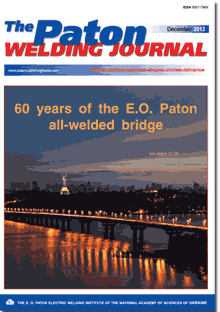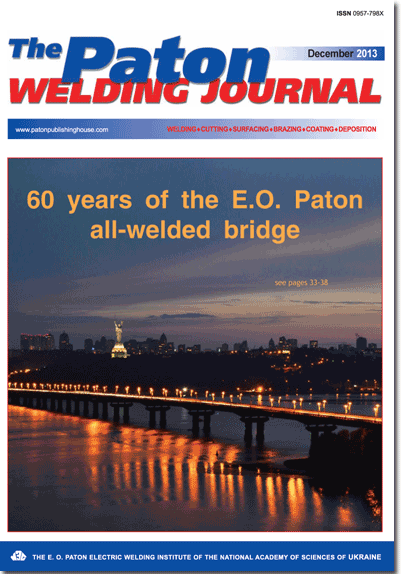| 2013 №12 (03) | 2013 №12 (05) |

The Paton Welding Journal, 2013, #12, 22-28 pages
OPTIMISATION OF CHEMICAL COMPOSITION AND STRUCTURE OF METAL OF REPAIR WELDS DURING ELIMINATION OF DEFECTS IN PIPE WELDED JOINTS USING MULTILAYER WELDING
A.A. RYBAKOV, T.N. FILIPCHUK and Yu.V. DEMCHENKO
E.O. Paton Electric Welding Institute, NASU, Kiev, Ukraine. 11 Bozhenko Str., 03680, Kiev, Ukraine. E-mail: office@paton.kiev.ua
Abstract
The structure and properties of metal of repair welds, produced using multipass welding during elimination of defects in welds of gas and oil pipelines, were investigated. The changes of chemical composition and impact toughness at negative temperatures and also peculiarities of structure characteristics of metal of separate passes of repair welds were determined. It was shown that in manual arc and mechanized submerged arc welding and welding in shielding gases applying consumables, conventional for manufacture of pipes, the metal of the last passes of repair weld is excessively enriched by different alloying elements (manganese, silicon, chromium, molybdenum, etc.) present in such materials. This leads to the formation of unfavorable structure: areas of upper bainite, developed grid of polygonization boundaries, boundary precipitates of carbon second phase, which in its turn provokes formation of cold cracks in welds. Considering the results of investigations the requirements were developed to the chemical composition of welding wire for repair of defects in pipe welds using multipass welding, providing restriction in the content of alloying elements. In multipass submerged arc welding it was also offered to use aluminate flux. The wire of recommended composition was tested during repair of defects in pipe welds using welding in shielding gas and provided high impact toughness of metal of repair welds in combination with a sufficient resistance against cracks formation. The results of investigations can be used for repair of defects in welds during manufacture of pipes and also in multipass welding of other metal structures. 5 Ref., 4 Tables, 7 Figures.
Keywords: pipe, weld, repair, defects, multipass welding, welding consumables, impact toughness, structure, cracks
Received: 11.07.13
Published: 28.12.13
References
1. DSTU ISO 3183-2:2006: Petroleum and natural gas industries. Steel pipes for pipelines. Technical delivery conditions. Pt 2: Pipes of class B requirements.
2. ANSI/API Specification 5L-2007. Specification for line pipes, ISO 3183:2007. Petroleum and natural gas industries. Steel pipes for pipelines. Technical delivery conditions.
3. DNV offshore standard OS-F101 (2007) Submarine pipeline systems. Det Norske Veritas.
4. Rybakov, A.A., Filipchuk, T.N., Goncharenko, L.V. (2013) Cracks in welded joints of large diameter pipes and measures for their prevention. The Paton Welding J., 4, 15-20.
5. Mandelberg, S.L., Bogachek, Yu.L., Kovalevsky, V.A. et al. (1986) Increase in impact toughness of weld metal of large-diameter pipes from microalloyed steels. Avtomatich. Svarka, 1, 36-40.
Suggested Citation
A.A. RYBAKOV, T.N. FILIPCHUK and Yu.V. DEMCHENKO (2013) OPTIMISATION OF CHEMICAL COMPOSITION AND STRUCTURE OF METAL OF REPAIR WELDS DURING ELIMINATION OF DEFECTS IN PIPE WELDED JOINTS USING MULTILAYER WELDING. The Paton Welding J., 12, 22-28.The cost of subscription/purchase order journals or individual articles
| Journal/Currency | Annual Set | 1 issue printed |
1 issue |
one article |
| TPWJ/USD | 384 $ | 32 $ | 26 $ | 13 $ |
| TPWJ/EUR | 348 € | 29 € | 24 € | 12 € |
| TPWJ/UAH | 7200 UAH | 600 UAH | 600 UAH | 280 UAH |
| AS/UAH | 1800 UAH | 300 UAH | 300 UAH | 150 UAH |
| AS/USD | 192 $ | 32 $ | 26 $ | 13 $ |
| AS/EUR | 180 € | 30 € | 25 € | 12 € |
| SEM/UAH | 1200 UAH | 300 UAH | 300 UAH | 150 UAH |
| SEM/USD | 128 $ | 32 $ | 26 $ | 13 $ |
| SEM/EUR | 120 € | 30 € | 25 € | 12 € |
| TDNK/UAH | 1200 UAH | 300 UAH | 300 UAH | 150 UAH |
| TDNK/USD | 128 $ | 32 $ | 26 $ | 13 $ |
| TDNK/EUR | 120 € | 30 € | 25 € | 15 € |
AS = «Automatic Welding» - 6 issues per year;
TPWJ = «PATON WELDING JOURNAL» - 12 issues per year;
SEM = «Electrometallurgy Today» - 4 issues per year;
TDNK = «Technical Diagnostics and Non-Destructive Testing» - 4 issues per year.


